If you are already learning Portuguese, then you understand that knowing the general grammar is not enough. Life puts us in different conditions and situations when we realize that general knowledge does not give us clear instructions on how to behave and what to say. Therefore, today for this article we have chosen a specific topic – in transport.
Ticket
To buy a ticket at the box office, you need to remember two main direction words: “de ida” – there, “de volta” – back. Now you just need to say one phrase and you will receive the coveted tickets:
Um bilhete para Peniche de ida às 11.55 e de volta às 18.15. (One ticket to Peniche, there at 11.55 and back at 18.15.)
Accordingly, the number of tickets, destination and time you can substitute your own.
Vocabulary
To begin with, let’s pick up a little vocabulary on this topic, because it is important to be able to clarify what kind of transport we use for movement.
taxi (taxi), elétrico (tram), barco (ship), autocarro (bus), camioneta (route taxi),
metro (subway), bicicleta (bicycle), avião (airplane)
Let’s add verbs to the list of necessary words that we can use with modes of transport:
viajar (to travel), usar (to use), andar (to go), voar (to fly)
The most versatile verb is “ir” (to go), which is suitable for absolutely any situation with movement.
We also need to know words like “partir” (to leave) and “chegar” (to arrive) in order to know when to catch a vehicle or meet friends.
A que horas chega o teu comboio? (What time does your train arrive?)
O comboio parte às 23.30, o caminho demorа 8 horas, então ele chega às 7.30. (The train leaves at 23.30, the journey takes 8 hours, so it arrives at 7.30)
Prepositions
There are two points to remember in this paragraph. First, we use two different prepositions, “de” and “em”, to describe the mode of transportation. Secondly, we use the preposition “de” only when we are talking about the transport in general, without specifics, and the preposition “em” is used just when we specify the number of the transport or its belonging. For example:
O Miguel vai para o trabalho de metro. (Miguel takes the subway to work.)
A Joana gosta de viajar no elétrico número 13 pela cidade. (Joana likes to travel by tram number 13 around the city.)
In the second example, the preposition “em” merged with the definite article “o” and it turned out – “no”.
In this section, we need three more prepositions: a, para, and por.
The prepositions “a” and “para” are similar in purpose. We have already said more than once that they indicate the direction of movement and differ only in the time spent at the end point: “a” – a short period of time, “para” – a long period of time.
The preposition “por” has a compeletely different purpose, which helps to describe the place where the movement takes place, that is:
Estou a andar de bicicleta por esta rua! (I’m cycling down this street!)
Let’s combine the knowledge we have gained and in the following example we will see how to correctly operate with prepositions:
Normalmente vou para o trabalho de metro, mas hoje houve greve e fui no autocarro número 13. Ele passou por todas as ruas calmas e estreitas. Não sabia que vivia numa cidade tão bonita! O autocarro não estava a andar, ele estava a voar – tranquilo e rápido, por isso tive tempo para ir a um café e tomar uma bica. Agora decidi que quero viajar de autocarro ou de bicicleta antes e depois do trabalho!
(Usually I go to work by metro, but today there was a strike and I took bus number 13. It went through all the quiet and narrow streets. I didn’t know that I live in such a beautiful city! The bus didn’t go, it flew – quietly and quickly so I had time to go to a coffee shop and have an espresso today I decided I want to travel by bus or bike before and after work!)
Useful Expressions
It is useful to know words like “entrar” (enter) and “sair” (exit). For example, when getting into a vehicle, you might ask; “Posso entrar?” (Can I enter?), and when leaving, if someone blocked your passage, you can find out: “Vai sair?” (Are you getting off?)
If you want to go into the interior of the transport and you think that you can disturb other passengers with your movement, you can say “com licença” (with your permission) or ask directly “posso passar?” (can I pass?). But if you want to give up a seat, you can offer the person “sente-se, se faz favor” (sit down, please).
Sometimes you may need to know what the next stop will be, then remember the phrase: “Qual é a próxima estação?”. If you are asked about it, you can use the template: “A próxima estação é …” (The next station is …) You also need to remember the expression “É preciso mudar de linha.” because it means that you need to change to another metro line.
Conclusion
A tourist who comes to Portugal can partly try on the life of an emigrant. Namely, to realize that you will have to learn elementary things again, for example, to buy a ticket for transport. Do not be afraid of this, because with the knowledge of the Portuguese language, all tasks are greatly simplified.
